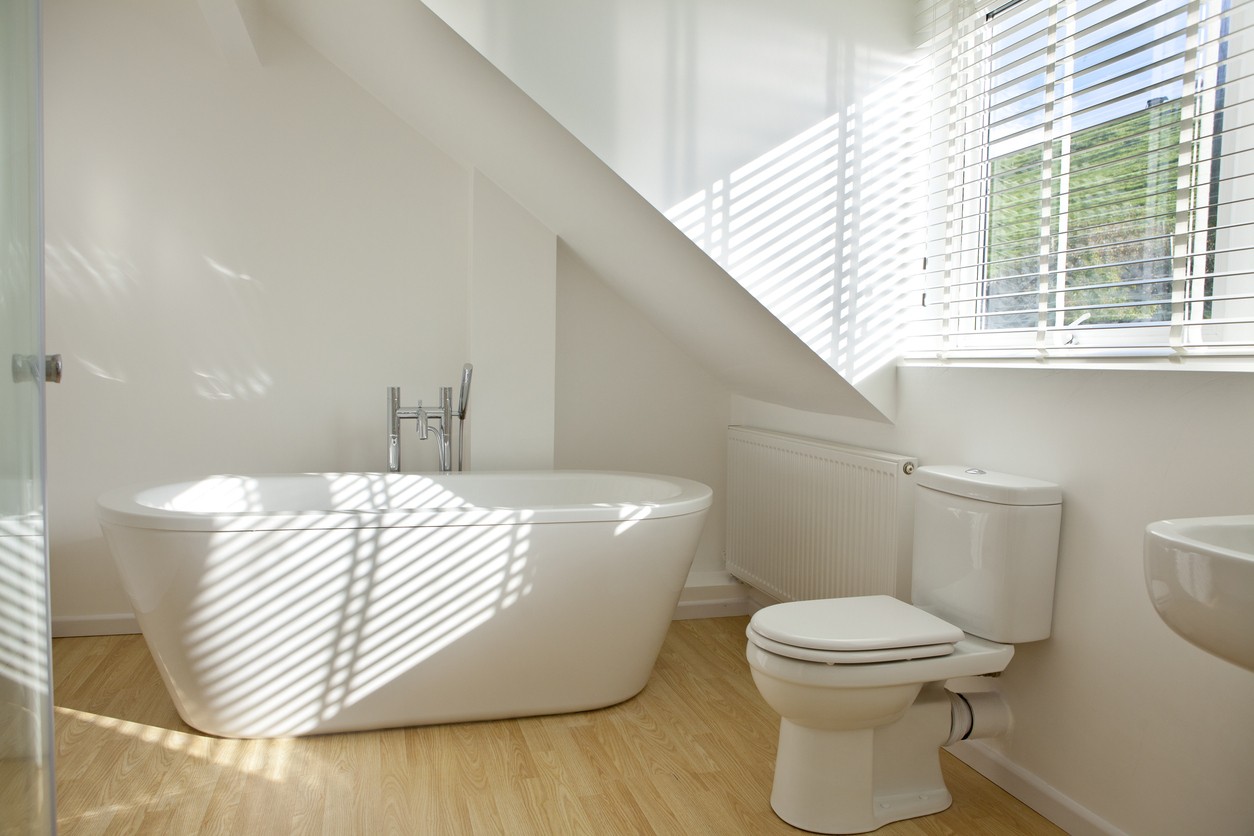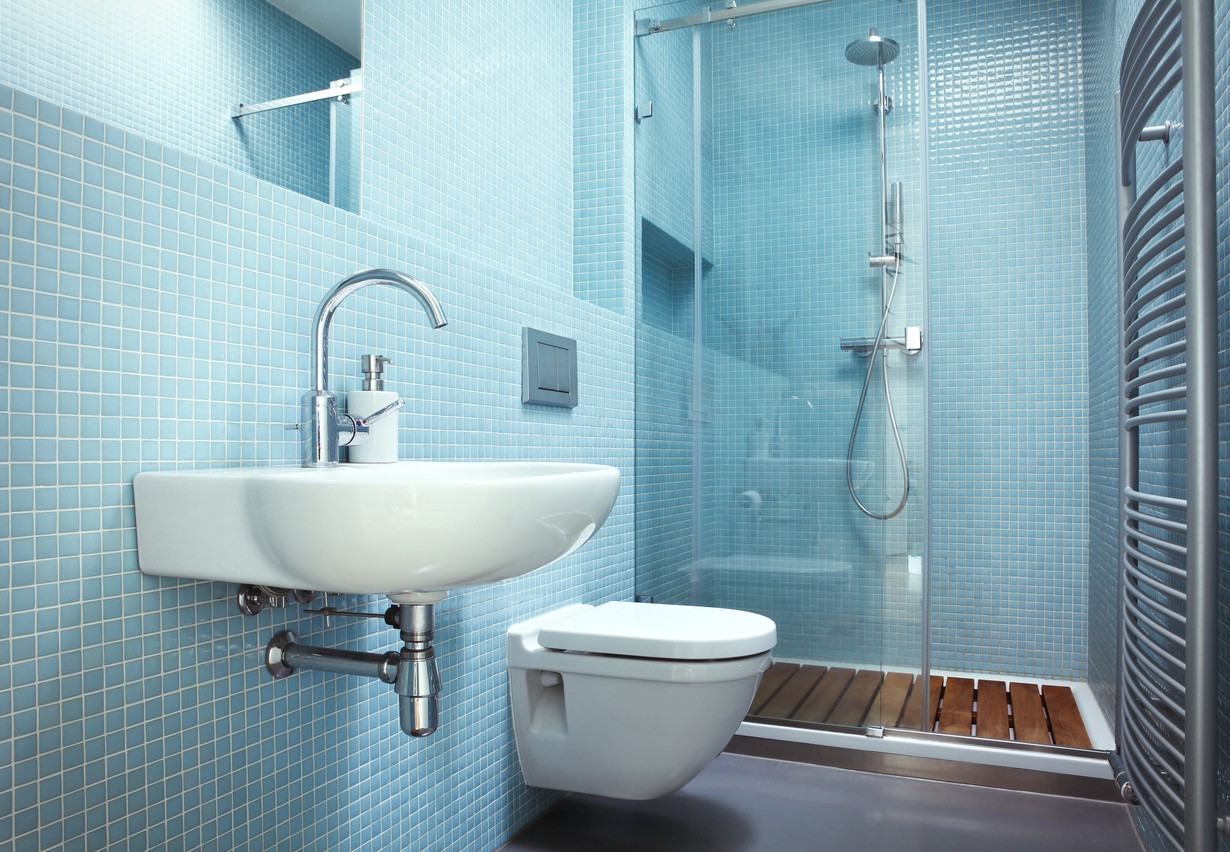What is a 3/4 bath? This is a common question, and WHAT.EDU.VN is here to provide a clear answer. A 3/4 bath offers a practical bathroom solution by combining essential fixtures, and understanding its composition and advantages can help you make informed decisions for your home. Discover the differences between full, half, and 3/4 baths, and explore the space-saving possibilities and design considerations to elevate your home’s comfort and value. Need quick answers? Ask WHAT.EDU.VN for free solutions today.
1. Understanding the Basics of a 3/4 Bath
A 3/4 bath is a bathroom that includes three of the four main fixtures found in a full bathroom: a toilet, a sink, and either a shower or a bathtub. It provides the core functionality of a bathroom without requiring as much space as a full bath, making it a popular choice for many homes. This setup caters to essential hygiene needs while optimizing space, and it fits well in guest rooms, smaller homes, or as an additional bathroom for convenience.
2. Key Components of a 3/4 Bath Explained
The three essential components of a 3/4 bath are the toilet, the sink, and either a shower or a bathtub. Most commonly, a 3/4 bath includes a standing shower rather than a bathtub, prioritizing space efficiency and modern living. While the layout can vary based on personal preferences and space constraints, the inclusion of these three fixtures defines a 3/4 bath.
2.1. Toilet Varieties for a 3/4 Bath
Toilets in a 3/4 bath can range from standard models to more modern, space-saving designs. Wall-mounted toilets, for example, can free up floor space and offer a sleek, minimalist look. Dual-flush toilets are also a great option for water conservation, reducing water usage without sacrificing performance. Comfort height toilets, which are slightly taller, can be more accessible for individuals with mobility issues.
2.2. Sink Options to Maximize Space
Sinks in a 3/4 bath can be just as varied as toilets, with options including pedestal sinks, wall-mounted sinks, and vanity sinks. Pedestal sinks are a classic choice that saves space, while wall-mounted sinks offer a modern, floating appearance. Vanity sinks, which combine a sink with a storage cabinet underneath, provide valuable storage space in a small bathroom. Choosing the right sink can significantly impact both the functionality and aesthetics of the 3/4 bath.
2.3. Shower or Bathtub? Weighing Your Options
The choice between a shower and a bathtub in a 3/4 bath often depends on personal preferences and the available space. Standing showers are more common due to their space-saving design and ease of use. However, some homeowners may prefer a bathtub, especially if they enjoy soaking or have young children who require bathing. Consider your lifestyle and needs when deciding which fixture to include.
3. Comparing 3/4 Bath vs. Full Bath vs. Half Bath
Understanding the differences between a 3/4 bath, a full bath, and a half bath can help you make the best choice for your home. A full bath includes all four main fixtures: a toilet, a sink, a shower, and a bathtub. A half bath, also known as a powder room, only includes a toilet and a sink. Knowing these distinctions is key when planning bathroom renovations or additions.
3.1. What Defines a Full Bath?
A full bath includes a toilet, a sink, a shower, and a bathtub. It’s the most comprehensive bathroom option, providing all the necessary fixtures for complete hygiene needs. Full baths are typically found in master bedrooms and main living areas, offering convenience and functionality for everyday use.
3.2. Understanding the Purpose of a Half Bath
A half bath, or powder room, includes only a toilet and a sink. It’s typically located near living areas or entryways, providing guests with a convenient place to use the restroom without needing to access private areas of the home. Half baths are ideal for saving space and minimizing plumbing costs.
3.3. Key Differences Summarized in a Table
| Feature | Full Bath | 3/4 Bath | Half Bath |
|---|---|---|---|
| Toilet | Yes | Yes | Yes |
| Sink | Yes | Yes | Yes |
| Shower | Yes | Yes or Bathtub | No |
| Bathtub | Yes | Yes or Shower | No |
| Total Fixtures | 4 | 3 | 2 |


4. The Practical Benefits of a 3/4 Bath
A 3/4 bath offers several practical benefits, making it a popular choice for homeowners. Its space-saving design, cost-effectiveness, and versatility make it an excellent addition to any home. Understanding these benefits can help you make an informed decision when planning bathroom renovations or additions.
4.1. Space-Saving Design for Smaller Homes
One of the primary benefits of a 3/4 bath is its space-saving design. By including only three fixtures, it requires less square footage than a full bath, making it ideal for smaller homes, guest rooms, or basement bathrooms. This compact design allows you to maximize your living space without sacrificing essential bathroom functionality.
4.2. Cost-Effectiveness Compared to a Full Bath
A 3/4 bath is generally more cost-effective than a full bath due to the reduced number of fixtures and the smaller space required. This can result in lower plumbing costs, less material expenses, and reduced labor fees. If you’re on a budget, a 3/4 bath can be a smart choice that still provides essential functionality.
4.3. Increased Home Value with an Extra Bathroom
Adding a 3/4 bath to your home can increase its overall value and appeal to potential buyers. Having an additional bathroom, even if it’s not a full bath, adds convenience and functionality to the home, making it more attractive to families and individuals alike. This can be a worthwhile investment that pays off in the long run.
5. Ideal Locations for a 3/4 Bath in Your Home
Choosing the right location for a 3/4 bath is crucial for maximizing its benefits. Ideal locations include guest rooms, basements, and secondary bedrooms. Consider the accessibility and convenience of the location when planning your bathroom renovation or addition.
5.1. Guest Room Convenience
Placing a 3/4 bath in a guest room provides visitors with their own private bathroom, offering convenience and privacy. This can make your guests feel more comfortable and welcome, enhancing their overall experience. A 3/4 bath in a guest room can also reduce the demand on the main bathrooms in the home.
5.2. Basement Bathroom Considerations
Adding a 3/4 bath to a basement can transform the space into a more functional and livable area. This is especially useful if the basement is used as a recreation room, home office, or guest suite. A 3/4 bath in the basement can also prevent the need to go upstairs to use the bathroom, adding convenience and comfort.
5.3. Secondary Bedrooms as a Practical Choice
Incorporating a 3/4 bath into a secondary bedroom can create a convenient and private space for family members or renters. This setup can be particularly appealing to older children or adults who value their privacy. It also reduces the congestion in the main bathrooms, making mornings more manageable for everyone.
6. Design Considerations for a Stylish 3/4 Bath
Designing a stylish 3/4 bath requires careful planning and attention to detail. From layout and fixture choices to lighting and decor, every element should work together to create a cohesive and functional space. Consider these design considerations to make the most of your 3/4 bath.
6.1. Optimizing Layout for Small Spaces
Optimizing the layout of a small 3/4 bath is crucial for maximizing space and functionality. Consider using a corner shower to save space, or opt for a wall-mounted sink to create a more open feel. Strategic placement of fixtures can make a small bathroom feel larger and more comfortable.
6.2. Choosing the Right Fixtures and Materials
Selecting the right fixtures and materials can significantly impact the look and feel of your 3/4 bath. Opt for high-quality, durable materials that can withstand moisture and wear. Choose fixtures that complement your overall design aesthetic, whether it’s modern, traditional, or somewhere in between.
6.3. Lighting and Ventilation Solutions
Proper lighting and ventilation are essential for creating a comfortable and functional 3/4 bath. Ensure adequate lighting with a combination of ambient, task, and accent lighting. Install a high-quality ventilation fan to prevent moisture buildup and maintain air quality. These elements can enhance the overall experience of using the bathroom.
7. Showers vs. Tubs: Making the Right Choice
Deciding between a shower and a tub for your 3/4 bath depends on your personal preferences, lifestyle, and space constraints. Showers are generally more space-efficient and convenient for quick cleaning, while tubs offer a relaxing option for soaking and bathing. Weigh the pros and cons of each to make the best choice for your needs.
7.1. Advantages of a Standing Shower in a 3/4 Bath
Standing showers offer several advantages in a 3/4 bath, including space efficiency, ease of access, and modern aesthetics. They take up less floor space than tubs, making them ideal for small bathrooms. They also offer easy entry and exit, which can be beneficial for individuals with mobility issues. Additionally, standing showers can be customized with various features, such as multiple showerheads, body sprays, and built-in seating.
7.2. The Appeal of a Bathtub in a 3/4 Bath
For some homeowners, a bathtub is a must-have for relaxation and personal care. A bathtub in a 3/4 bath provides a place to unwind after a long day, soak sore muscles, and enjoy a spa-like experience at home. If you enjoy taking baths or have young children who require bathing, a bathtub may be the right choice for your 3/4 bath.
7.3. Factors to Consider When Deciding
When deciding between a shower and a tub, consider your lifestyle, preferences, and the needs of your household. If you prefer quick, convenient cleaning and have limited space, a standing shower may be the best option. If you value relaxation and have the space to accommodate a tub, it may be the better choice. Also, consider the resale value of your home, as some buyers may prefer having at least one bathtub in the house.
8. Increasing Home Value with a 3/4 Bath
Adding a 3/4 bath can increase your home’s value by providing an additional bathroom, which is a desirable feature for many buyers. It adds convenience, functionality, and appeal to your home, making it more competitive in the real estate market. Understand how a 3/4 bath can impact your home’s value and make it a worthwhile investment.
8.1. How an Additional Bathroom Impacts Resale Value
An additional bathroom, whether it’s a full bath or a 3/4 bath, can significantly impact your home’s resale value. Buyers often look for homes with multiple bathrooms to accommodate their families and guests. Adding a 3/4 bath can make your home more attractive to potential buyers and increase its overall value.
8.2. Appealing to Potential Home Buyers
Having a 3/4 bath can make your home more appealing to potential buyers, especially those with families or frequent guests. It provides an additional space for personal care, reducing congestion in the main bathrooms and adding convenience to daily routines. A well-designed 3/4 bath can be a selling point that sets your home apart from others on the market.
8.3. Investment vs. Return: Is It Worth It?
While adding a 3/4 bath involves an initial investment, the return on that investment can be significant in terms of increased home value and buyer appeal. The cost of adding a 3/4 bath can vary depending on the location, size, and materials used, but it’s generally a worthwhile investment that pays off in the long run. Consider the potential benefits and consult with a real estate professional to determine the best course of action for your home.
9. DIY vs. Hiring a Professional for 3/4 Bath Installation
When it comes to installing a 3/4 bath, you have the option of doing it yourself or hiring a professional. DIY installation can save you money on labor costs, but it requires a certain level of skill and experience. Hiring a professional ensures that the job is done correctly and up to code, but it comes at a higher cost. Weigh the pros and cons of each option to make the best choice for your situation.
9.1. Assessing Your DIY Skills and Experience
Before attempting a DIY 3/4 bath installation, honestly assess your skills and experience in plumbing, electrical work, and carpentry. If you have limited experience in these areas, it may be best to hire a professional to avoid costly mistakes and ensure the job is done safely and correctly. Consider the complexity of the project and your comfort level before making a decision.
9.2. Benefits of Hiring a Professional Plumber
Hiring a professional plumber offers several benefits, including expertise, experience, and adherence to building codes. A licensed plumber can ensure that the plumbing is installed correctly, preventing leaks, clogs, and other issues. They can also handle any unexpected problems that may arise during the installation process. While it comes at a higher cost, hiring a professional plumber can give you peace of mind and ensure a quality installation.
9.3. Budgeting for Professional Installation
When budgeting for professional 3/4 bath installation, get multiple quotes from different contractors to compare prices and services. Be sure to factor in the cost of materials, labor, permits, and any potential unexpected expenses. While it may be tempting to go with the lowest bid, consider the contractor’s reputation, experience, and references before making a decision. A well-planned budget can help you avoid overspending and ensure a successful installation.
10. Common Mistakes to Avoid in a 3/4 Bath Remodel
Remodeling a 3/4 bath can be a challenging project, and it’s important to avoid common mistakes that can lead to costly delays and unsatisfactory results. From improper planning and poor material choices to inadequate ventilation and incorrect plumbing, these mistakes can derail your remodel and leave you with a bathroom that doesn’t meet your needs. Learn from these common errors and take steps to avoid them in your own 3/4 bath remodel.
10.1. Improper Planning and Measurement
One of the most common mistakes in a 3/4 bath remodel is improper planning and measurement. Failing to accurately measure the space and plan the layout can result in fixtures that don’t fit, wasted materials, and a cramped, uncomfortable bathroom. Take the time to carefully measure the space and create a detailed plan before starting any work.
10.2. Poor Material Choices and Quality
Choosing poor-quality materials can lead to premature wear and tear, water damage, and a bathroom that looks outdated and unattractive. Opt for high-quality, durable materials that can withstand moisture and daily use. Invest in fixtures and finishes that will stand the test of time and maintain their appearance for years to come.
10.3. Neglecting Ventilation and Waterproofing
Neglecting ventilation and waterproofing can lead to moisture buildup, mold growth, and structural damage. Ensure that your 3/4 bath has adequate ventilation to remove excess moisture and prevent mold. Properly waterproof the shower area and any other areas that are exposed to water to protect the walls and floors from damage.
Do you still have questions about 3/4 baths? Don’t hesitate to ask! At WHAT.EDU.VN, we provide free answers to all your questions. Our community of experts is ready to assist you with any queries you may have.
Ready to get started?
Visit us today at WHAT.EDU.VN and ask your question for free!
Contact Information:
- Address: 888 Question City Plaza, Seattle, WA 98101, United States
- WhatsApp: +1 (206) 555-7890
- Website: what.edu.vn
